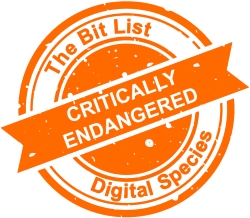Media Inside Paper Files
 |
||
|
Media inside paper files occurred in records since the 1980s and will continue to do so for many years. |
||
|
Digital Species: Portable Media |
Trend in 2023:
|
Consensus Decision |
|
Added to List: 2019 |
Trend in 2024:
|
Previously: Critically Endangered |
|
Imminence of Action Action is recommended within three years, detailed assessment within one year. |
Significance of Loss The loss of tools, data or services within this group would impact on people and sectors around the world. |
Effort to Preserve | Inevitability It would require a major effort to prevent or reduce losses in this group, possibly requiring the development of new preservation tools or techniques. |
|
Examples Digital media mixed with paper files in records offices and filing cabinets of almost every kind of enterprise. |
||
|
‘Practically Extinct’ in the Presence of Aggravating Conditions Unsustainable effort to assess; exotic or obsolete media; poor storage; lack of descriptive labelling; uncertainty over IPR or the presence of orphaned works. |
||
|
‘Endangered’ in the Presence of Good Practice Carefully labelled; managed programme of assessment and retrieval; robust media used. |
||
|
2023 Review This entry was added in 2019 to report the significant amounts of digital media being transferred to archives folded into traditional files. The 2019 Jury noted that it is relatively simple to preserve this material once identified using standard tools, but it can be an ‘unknown unknown,’ and that assessment can seem overwhelming and, therefore it may overlap with other portable media risks but has a higher risk classification. The 2021 Jury agreed on a 2021 trend towards greater risk due to the increased time sensitivity and need for conducting collection audits as soon as possible, in order to determine what you have to then work out a plan about opening carriers, assessing files, and extracting them if significant. The 2022 Taskforce agreed, with risks on the same basis as before (‘No change’ to trend) The 2023 Council agreed with the risk classification of Critically Endangered with the overall risks remaining on the same basis as before (‘No change’ to trend). . |
||
|
2024 Interim Review These risks remain on the same basis as before, with no significant trend towards even greater or reduced risk (‘No change’ to trend). |
||
|
Additional Comments This is highly dependent on who is looking after the portable formats. There are good examples, for example in libraries, where disks are stored at the back of books or in front of magazines and can be processed at the point of acquisition. In archives, however, dealing with bit-level preservation of external media (often on legacy formats) is largely an unquantified problem, and so resource commitments will not be in place. So, there is a method and tools but simply no time committed and no proper assessment either. In other agencies, the issue will not have even been considered, and for them, it will be much harder over time with some inevitable loss. |
||









































































































































